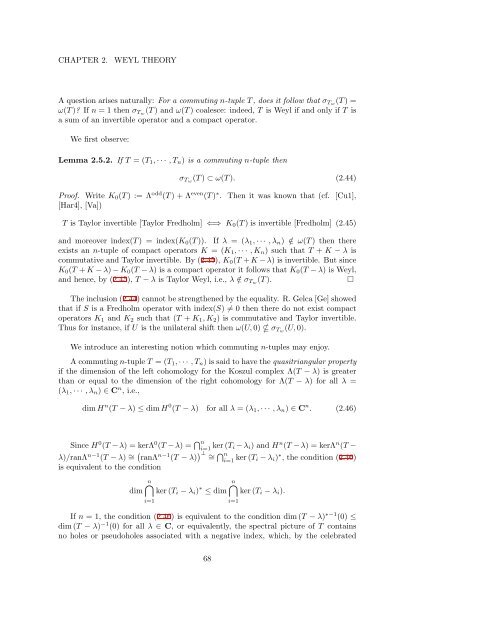Woo Young Lee Lecture Notes on Operator Theory
Woo Young Lee Lecture Notes on Operator Theory
Woo Young Lee Lecture Notes on Operator Theory
Create successful ePaper yourself
Turn your PDF publications into a flip-book with our unique Google optimized e-Paper software.
CHAPTER 2.<br />
WEYL THEORY<br />
A questi<strong>on</strong> arises naturally: For a commuting n-tuple T , does it follow that σ Tw (T ) =<br />
ω(T ) If n = 1 then σ Tw (T ) and ω(T ) coalesce: indeed, T is Weyl if and <strong>on</strong>ly if T is<br />
a sum of an invertible operator and a compact operator.<br />
We first observe:<br />
Lemma 2.5.2. If T = (T 1 , · · · , T n ) is a commuting n-tuple then<br />
σ Tw (T ) ⊂ ω(T ). (2.44)<br />
Proof. Write K 0 (T ) := Λ odd (T ) + Λ even (T ) ∗ . Then it was known that (cf. [Cu1],<br />
[Har4], [Va])<br />
T is Taylor invertible [Taylor Fredholm] ⇐⇒ K 0 (T ) is invertible [Fredholm] (2.45)<br />
and moreover index(T ) = index(K 0 (T )). If λ = (λ 1 , · · · , λ n ) /∈ ω(T ) then there<br />
exists an n-tuple of compact operators K = (K 1 , · · · , K n ) such that T + K − λ is<br />
commutative and Taylor invertible. By (2.45), K 0 (T + K − λ) is invertible. But since<br />
K 0 (T + K − λ) − K 0 (T − λ) is a compact operator it follows that K 0 (T − λ) is Weyl,<br />
and hence, by (2.45), T − λ is Taylor Weyl, i.e., λ /∈ σ Tw (T ).<br />
□<br />
The inclusi<strong>on</strong> (2.44) cannot be strengthened by the equality. R. Gelca [Ge] showed<br />
that if S is a Fredholm operator with index(S) ≠ 0 then there do not exist compact<br />
operators K 1 and K 2 such that (T + K 1 , K 2 ) is commutative and Taylor invertible.<br />
Thus for instance, if U is the unilateral shift then ω(U, 0) σ Tw (U, 0).<br />
We introduce an interesting noti<strong>on</strong> which commuting n-tuples may enjoy.<br />
A commuting n-tuple T = (T 1 , · · · , T n ) is said to have the quasitriangular property<br />
if the dimensi<strong>on</strong> of the left cohomology for the Koszul complex Λ(T − λ) is greater<br />
than or equal to the dimensi<strong>on</strong> of the right cohomology for Λ(T − λ) for all λ =<br />
(λ 1 , · · · , λ n ) ∈ C n , i.e.,<br />
dim H n (T − λ) ≤ dim H 0 (T − λ) for all λ = (λ 1 , · · · , λ n ) ∈ C n . (2.46)<br />
Since H 0 (T − λ) = kerΛ 0 (T − λ) = ∩ n<br />
i=1 ker (T i − λ i ) and H n (T − λ) = kerΛ n (T −<br />
λ)/ranΛ n−1 (T − λ) ∼ = ( ranΛ n−1 (T − λ) )⊥ ∼ =<br />
∩ n<br />
i=1 ker (T i − λ i ) ∗ , the c<strong>on</strong>diti<strong>on</strong> (2.46)<br />
is equivalent to the c<strong>on</strong>diti<strong>on</strong><br />
n∩<br />
n∩<br />
dim ker (T i − λ i ) ∗ ≤ dim ker (T i − λ i ).<br />
i=1<br />
If n = 1, the c<strong>on</strong>diti<strong>on</strong> (2.46) is equivalent to the c<strong>on</strong>diti<strong>on</strong> dim (T − λ) ∗−1 (0) ≤<br />
dim (T − λ) −1 (0) for all λ ∈ C, or equivalently, the spectral picture of T c<strong>on</strong>tains<br />
no holes or pseudoholes associated with a negative index, which, by the celebrated<br />
i=1<br />
68













